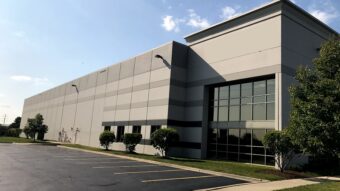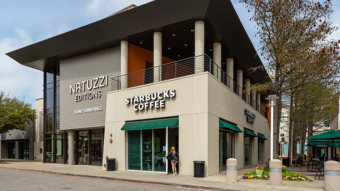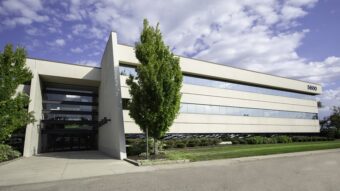Think of green commercial building and what springs to mind? Apartment towers with rooftop gardens? How about office buildings equipped with low-flow toilets and energy-efficient windows?
It’s true that office buildings and multifamily projects make up a large portion of the LEED-certified commercial properties across the country. But it’s easy to forget that industrial buildings — warehouses, distribution centers and factories — can also be green.
The number of industrial buildings that have achieved LEED certification status is steadily growing. According to the U.S. Green Building Council, as of 2013 a total of 117 industrial manufacturing facilities had earned LEED certification. These buildings accounted for 41 million gross square feet of green industrial space.
An additional 703 industrial projects had registered for LEED certification as of 2013, buildings that totaled 221 million square feet. The U.S. Green Building Council said that the market of green industrial buildings had grown by 375 percent in the four years leading up to 2013.
This is no surprise to Karl Heitman, president and founder of Heitman Architects Incorporated in Itasca, Illinois. Heitman said that building green, and seeking LEED certification, is a smart financial move for the owners of industrial buildings. At the same time, green warehouses and manufacturing space makes good economic sense for the companies that lease or buy industrial space.
Green buildings consume less energy. For the owners and tenants of industrial facilities, this will result in lower operating costs each year. Green buildings are also healthier workplaces, Heitman said, resulting in healthier and more productive employees.
“There is a lot of potential when it comes to industrial facilities and green building,” Heitman said. “Green is a smart thing to do economically for industrial developers.”
Reasons to go green
Heitman said that there are two main reasons why industrial developers build green. First, they can reduce their operating costs through energy savings and tax credits.
“When you get that better envelope, those higher insulation values and that higher-efficiency lighting, you will get buildings that consume less energy,” Heitman said. “Green buildings also take advantage of daylighting through clerestory windows or skylights. That also reduces the amount of energy buildings industrial buildings consume each year.”
The U.S. Green Building Council says that LEED-certified buildings also report maintenance costs that are almost 20 percent lower than do traditional commercial buildings. Green retrofit projects typically lower operating costs by almost 10 percent in just one year, according to the council.
Building owners can also qualify for the 179D tax credit, also known as the Commercial Building Deduction, when their buildings meet certain energy-efficient guidelines. This is another source of financial savings for which industrial owners can qualify.
Green buildings also increase in value quickly, with the U.S. Green Building Council reporting that green features make the average building an instant 4 percent more valuable than the same facility would be without green features.
This means that the return on investment that owners receive by building green is rapid. The U.S. Green Building Council says that green retrofit projects, including on industrial facilities, pay for themselves in an average of just seven years.
The second big reason for owners to go green? Employees who get more work done.
Heitman said that productive employees are an often-ignored benefit of green industrial buildings.
“Green buildings generally have employees who are more productive,” Heitman said. “Having that natural daylight, clean air and less CO2 creates higher productivity and lower absenteeism. Green buildings also tend to attract employees. They help companies retain their best employees, too.”
Attracting tenants
Largely because of these benefits, the owners of industrial buildings often find it easier to attract tenants to fill their space. That’s because companies today increasingly understand the value of working from a green space, Heitman said.
Then there are consumers. Today’s consumers increasingly want to purchase products that have come from green, sustainable manufacturing facilities, Heitman said. That’s another incentive for tenants to locate in green industrial properties. And it’s another incentive for owners who want to attract these tenants.
The Chicago area is home to many LEED-certified industrial projects. Heitman and his company, for instance, partnered with Summit DB and William McDonough + Partners on the Method Soap facility that began operating in Chicago’s Pullman neighborhood last year.
Workers at this LEED-Platinum facility manufacture and ship environmentally sustainable hand and dish soap. The site is powered by a 250-foot-tall commercial-grade wind turbine. It also boasts pohto-voltaic solar panels over the parking area. It even has its own roof-top farm.
“That is an impressive facility, but it’s not just a philanthropic effort. It was a businessman who put that plan together,” Heitman said. “The reason that facility works is because it makes business sense. It reduced the costs of the company’s supply chain. It relies on renewable energy sources, so it also reduces the operations costs.”
That facility has received plenty of press. But there are other LEED industrial facilities scattered across the Chicago area that have been just as important.
Heitman’s company worked with Clarius Partners on that company’s more than 1-million-square-foot warehouse in the company’s master-planned Clarius Park Joliet in the south Chicago suburb of Joliet. That building received LEED-Silver certification back in 2014.
Heitman Architects also worked with Peak Construction Corporation on a Sunstar facility in Schaumburg. This LEED-certified building features a 365-foot-long 22-foot-high glass wall that overlooks the facility’s manufacturing floor. This allows nature daylight to wash over the floor, providing a healthier environment for workers and lower operating costs for Sunstar.
“The costs of going green have pretty much gone away,” Heitman said. “To get a baseline LEED-certified building today doesn’t involve nearly as many hard costs as it once did. To get to Silver, Gold or Platinum levels, yes, you are talking about some additional costs. But for baseline LEED projects, the buildings being designed today come with only minor increases in hard building costs.”
That doesn’t mean that there aren’t some additional costs to getting LEED certification. Owners will have to pay for the process itself of getting certified. That cost can range from $50,000 to $100,000, Heitman said.
“Some developers really understand the value of green building,” Heitman said. “They understand that there is a corporate social responsibility for going green. But they also understand that building green gives them a benefit that they can pass onto their tenants. Their tenants are looking for greener solutions, so they are attracted to green buildings. That is a benefit to the owners and developers of industrial facilities.”
Heitman said that he expects to see even more green industrial facilities to pop up around the Chicago area in the coming months. Already, the bigger companies, the Fortune 500 firms, are routinely going green with their manufacturing and warehouse facilities, he said. The number of smaller companies pursuing green is also increasing, although at a slower pace, Heitman said.
“Once more tenants and companies start demanding it, the mass market will change,” Heitman said. “Most developers will follow the demand. If companies are demanding green, they will follow that demand.”



